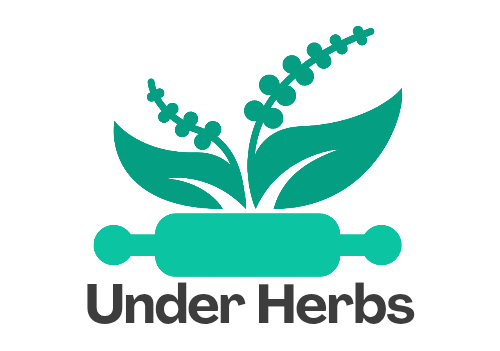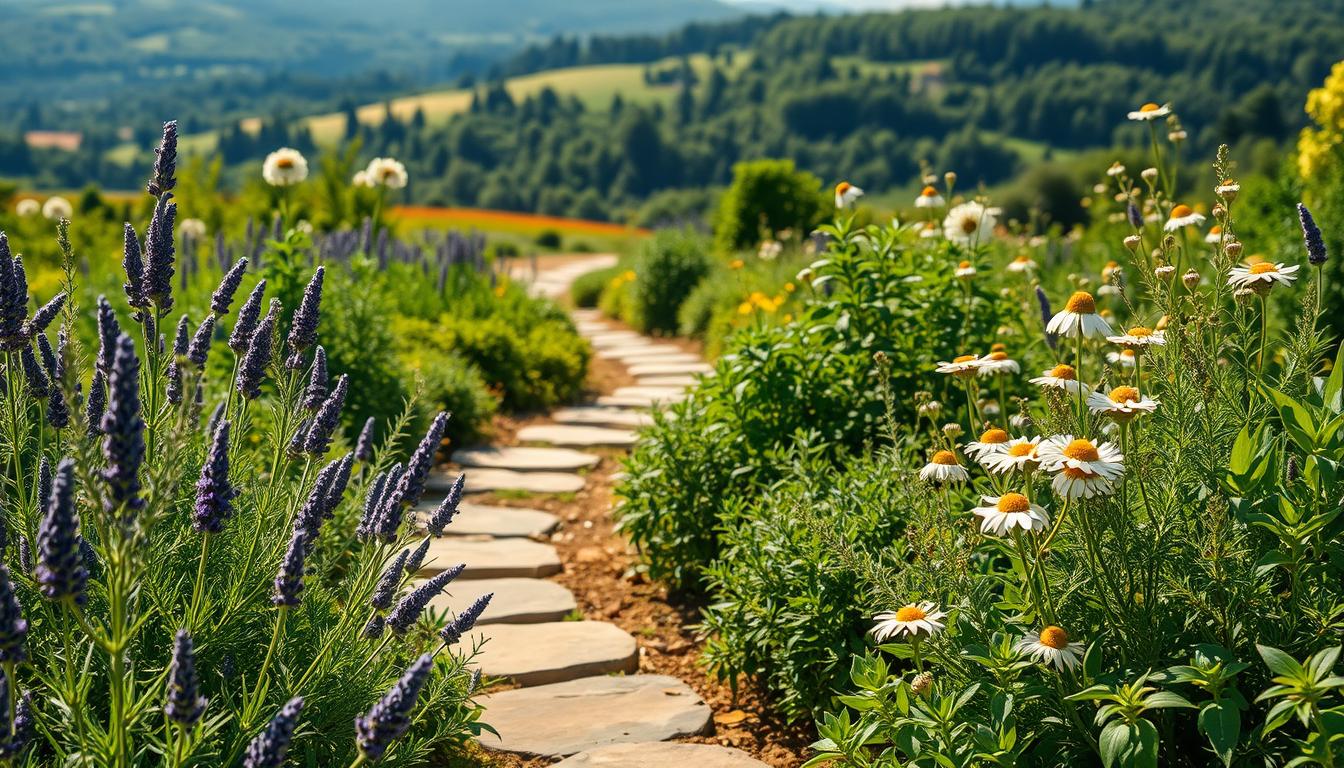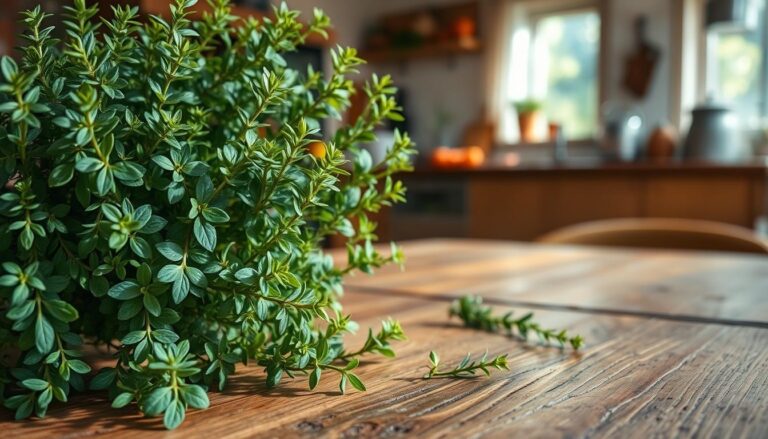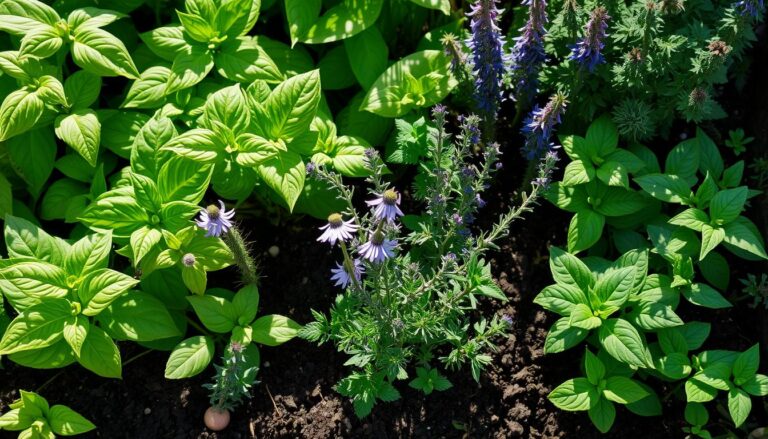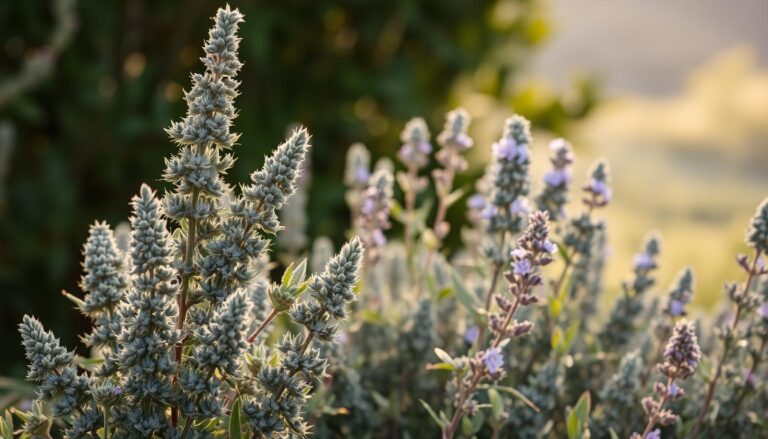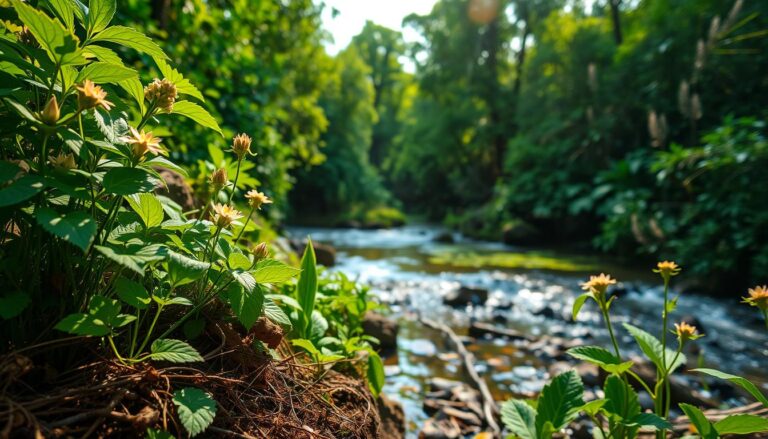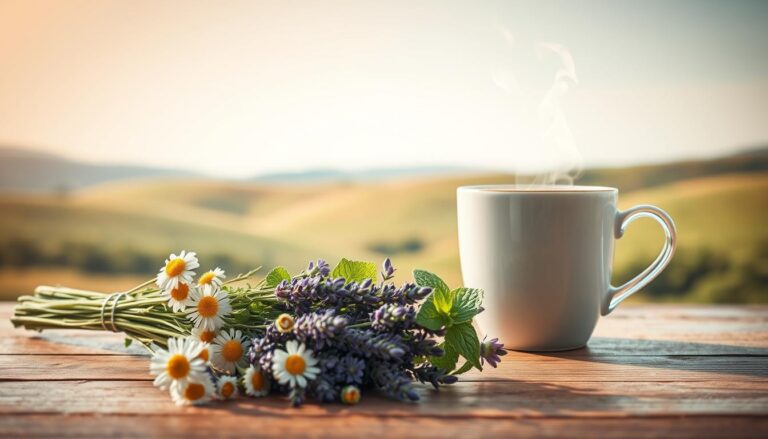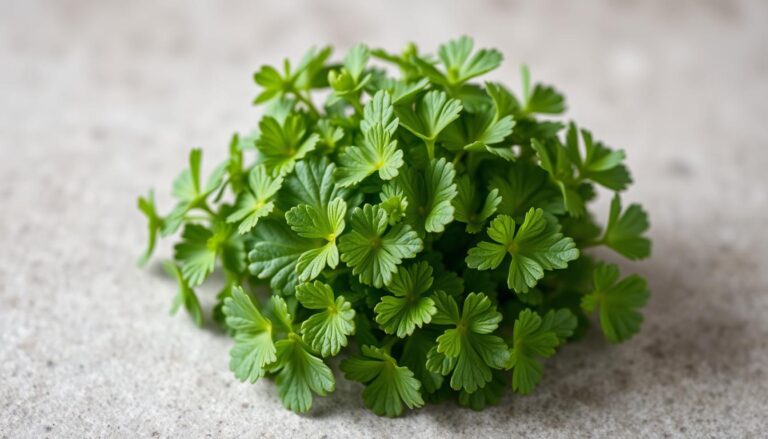Cultivate a Medicinal Garden for Health
Last summer, as I tended to my herbs, I realized how they changed my health and wellness. The smell of rosemary and the movement of peppermint helped me relax and feel better. Gardening is more than a hobby; it’s a key part of my life, offering both physical and emotional nourishment.
Studies show that gardening boosts physical activity and diet. It also fights stress and brings people together1. Starting my own medicinal garden showed me the power of natural medicine. Fresh herbs from my garden are better than store-bought ones, connecting me to nature.
Now, I think it’s a great time for you to start your own organic garden. Fill it with medicinal herbs that heal and nourish you.
Key Takeaways
- Engaging in gardening can lead to improved physical health and overall well-being.
- Therapeutic plants like medicinal herbs can serve as natural remedies for common ailments.
- Cultivating a personal garden fosters a sustainable practice for both you and the environment.
- The act of gardening has been linked to stress reduction and better mental health.
- Growing your own medicinal herbs encourages healthier eating habits and empowers individual health management.
Introduction to Medicinal Gardens
Creating a medicinal garden is a rewarding experience. It blends gardening art with herbal science. I love growing herbs for their beauty and healing powers. Medicinal plants have helped people for centuries, offering natural health solutions.
In today’s world, more people want natural health options. Growing these plants at home lets us take care of our health. It’s empowering.
Designing a medicinal garden requires choosing the right herbs for my area. Herbs like lavender and chamomile are calming. Each herb has its own health benefit, helping us live healthier.
Growing herbs connects us to nature. It deepens our understanding of natural medicine. It also makes us more self-sufficient in health care.
Medicinal gardens help us deal with minor health issues and improve overall health. They make our homes better and our lives richer. Plus, they bring us closer to nature’s pharmacy.
The Benefits of a Medicinal Garden
Starting a medicinal garden brings many benefits for health lovers and those wanting to live better. It lets me easily treat common problems, making me more self-sufficient. Using healing herbs daily helps me stay healthy in the long run.
Natural Remedies for Common Ailments
My garden has natural cures for many issues. Echinacea boosts my immune system, fighting off colds and respiratory problems. Peppermint helps with stomach issues, and chamomile calms me down, perfect for stress relief. These plants offer quick, effective treatments right in my home.
Enhancing Family Health and Wellness
My medicinal garden benefits everyone in my family. It teaches us all about health and wellness together. Herbs like oregano and turmeric add flavor and health to our meals.
This habit makes us think more about what we eat. It shows us how important natural remedies are. With this knowledge, my family and I can take care of our health together.
Choosing the Right Herbs for Your Medicinal Garden
Choosing the right herbs for your medicinal garden is key. Knowing the healing properties of each herb boosts their health benefits. Herbs like calendula, holy basil, and lemon balm are popular for their unique health uses.
Popular Healing Herbs to Consider
Here are some healing herbs to add to your garden:
- Calendula: Known for its anti-inflammatory and wound-healing powers.
- Holy Basil: Used to lower stress and boost overall health.
- Lemon Balm: Helps with anxiety and improves sleep.
Herbs for Specific Health Concerns
Some herbs target specific health issues:
- Chamomile: Great for digestion and relaxation.
- Ginger: Helps with nausea and breathing problems.
- Lavender: Known for its calming effects and headache relief.
By adding these herbs to my garden, I can make herbal remedies for my family. Each herb’s special benefits help us stay healthy. Finding the right mix is crucial for healing.
Planning Your Medicinal Garden Layout
Creating a well-organized medicinal garden layout is key to getting the most health benefits from your herbs. I need to decide if I should garden indoors or outdoors, based on my space and climate. Each choice has its own benefits, like managing sunlight and using space wisely for growth.
Indoor vs. Outdoor Medicinal Gardens
Indoor gardening lets me control the environment, growing herbs all year, no matter the weather. Outdoor gardening, however, offers natural sunlight, which is great for plant health. I weigh my options and resources to pick the best for my garden.
Sunlight and Space Considerations
When planning, it’s important to think about sunlight. For outdoor gardens, I look for spots that get enough light all day. For indoor gardens, I might use grow lights to help with natural light. It’s also crucial to use space well, whether indoors or outdoors.
Using vertical planting or grouping herbs by their needs can make my garden more productive and beautiful. This way, I can make sure my garden supports my health and wellness goals. I aim to mix herbs for both indoor and outdoor gardens, ensuring they get the right sunlight and enough room to grow.

Preparing the Garden Soil for Medicinal Herbs
Starting a medicinal garden needs a solid base: the soil. Good soil preparation gives plants the nutrients they need to grow well. Organic soil is best because it’s good for plants and the environment.
Importance of Organic Soil
Organic soil is key for growing medicinal herbs. It helps plants by improving soil health and drainage. By avoiding harmful chemicals, we create a better place for herbs to grow.
Healthy soil means stronger plants. These plants can fight off pests and diseases better.
Compost: Building Nutrient-Rich Growing Medium
Composting makes great soil for herbs. It turns kitchen and yard waste into nutrient-rich compost. This compost makes the soil better for plants.
It also brings in good bugs that help the soil. This makes the soil even healthier.
| Type of Compost | Benefits | Ideal Uses |
|---|---|---|
| Kitchen Scraps | Rich in nitrogen; accelerates microbial activity | Mix with garden soil for planting |
| Yard Waste | Provides carbon; improves soil structure | Add to compost pile for balance |
| Manure | High in nutrients; enhances soil fertility | Mix into garden beds before planting |
Quality compost and good composting skills are crucial. They help make soil that’s perfect for medicinal herbs. A strong soil foundation is vital for a successful medicinal garden.
Planting Techniques for a Thriving Medicinal Garden
Starting a medicinal garden can be exciting. Choosing between seeds and transplants is key to success. Each method has its own benefits and challenges.
Starting from Seeds vs. Transplants
When picking between seeds and transplants, I consider several things. Seeds are cheaper but take longer to grow. Transplants grow faster, but they cost more.
| Method | Advantages | Disadvantages |
|---|---|---|
| Seeds | Cost-effective, wide variety, self-sourcing | Longer growth time, requires careful monitoring |
| Transplants | Faster results, easier initial growth | Higher cost, limited variety |
Timing Your Planting Schedule
Timing is everything in a medicinal garden. I check local frost dates to know when to plant. Cool-season herbs like parsley do well in spring. Warm-season herbs like basil grow better when it’s warmer.

Using the right planting methods and timing is crucial. It helps my herbs grow strong and healthy. This way, I’m ready for a bountiful harvest and can fulfill my gardening dreams.
Caring for Your Medicinal Garden
Keeping a medicinal garden healthy needs some key steps. Regular care helps plants grow strong and ready for use. I focus on watering and maintenance to help them thrive. It’s also vital to use pest control that’s good for the environment.
Watering and Maintenance Practices
Watering is key for your plants’ health. I suggest watering deeply to help roots grow. This also keeps weeds away. Here are some important care tips:
- Check soil moisture levels regularly.
- Water in the morning to minimize evaporation.
- Use mulch to retain soil moisture and suppress weeds.
- Prune dead or diseased plant parts promptly to prevent the spread of issues.
Pest Control and Sustainable Practices
Using green pest control is crucial to keep my plants safe. Companion planting is a great way to keep pests away. Here are some methods I use:
| Pest | Control Method | Beneficial Insects |
|---|---|---|
| Aphids | Introduce ladybugs and use neem oil | Ladybugs, lacewings |
| Slugs | Place beer traps or diatomaceous earth | N/A |
| Whiteflies | Use yellow sticky traps and natural predators | Parasitic wasps |
By using these care and pest control tips, I create a healthy garden ecosystem.
Harvesting and Conserving Your Medicinal Herbs
Harvesting and preserving herbs is key to keeping their medicinal value. I follow best practices to keep my herbs potent and of high quality. Knowing the difference between dried and fresh herbs helps me use and store them better.
Best Practices for Harvesting
For the best results, I harvest herbs in the early morning. This is when they are at their most potent. I use clean, sharp tools to avoid damaging the plants. Cutting just above a node encourages new growth and keeps my supply fresh.
After harvesting, I gently wash and dry the herbs. This step is important to remove excess moisture.
Methods of Preservation: Dried Herbs vs. Fresh
There are several ways to preserve herbs, each with its own benefits. Drying herbs is a popular choice for long-term storage. It helps keep their flavor intact for a longer time.
Dried herbs are great for cooking and measuring. Fresh herbs, however, offer a stronger taste and aroma right after picking. I use both methods and store dried herbs in airtight containers. This keeps them fresh for later use.
For fresh herbs, I keep them in water or wrap them in damp paper towels. This helps them stay fresh longer in the fridge.

Understanding how to harvest and preserve herbs allows me to enjoy them all year.
Creating Herbal Remedies from Your Medicinal Garden
Creating herbal remedies from my medicinal garden has changed me. I make infusions, tinctures, and salves to improve my health. Each method has its own benefits and is easy to do.
Infusions, Tinctures, and Salves Explained
Infusions are simple to make. I steep dried herbs in hot water for 10–15 minutes. This extracts the herbs’ flavors and benefits. Herbs like chamomile and peppermint are great for calming.
Tinctures involve soaking herbs in alcohol or vinegar for weeks. This extracts their medicinal compounds. They are strong and can be taken in small doses. Salves, made with infused oils and beeswax, are good for the skin or muscles.
Using Herbs in Daily Wellness
Using these remedies daily has boosted my health. I start with herbal infusions to energize. Tinctures are in my bag for stress or pain. Making my own remedies makes me feel empowered and connected to my health.
Here’s a quick comparison of the three methods:
| Method | Preparation Time | Use | Benefits |
|---|---|---|---|
| Infusion | 10–15 minutes | Drink | Energizing, soothing |
| Tincture | Several weeks | Dropper dosage | Concentrated herbal effects |
| Salve | 1–2 hours | Topical application | Moisturizing, pain relief |
Using my harvested herbs for remedies has deepened my connection to natural wellness. I suggest trying these methods for your health. They can have a big impact on your daily life.
Community and Educational Resources for Medicinal Gardening
Getting involved in community gardening is a great way to learn and work together. I’ve found that local gardening workshops improve my skills and connect me with others. These workshops let me practice with medicinal plants and learn from experts.
There are also many online resources to learn from. Sites like the American Herbalists Guild have courses for all levels. These resources help me understand medicinal gardening better.
Being part of local clubs or online forums has been a big help. I share tips, stories, and find new resources. This way, I grow my garden and build friendships, showing how important community is.
Conclusion
Cultivating a medicinal garden has changed my life for the better. Growing my own herbs gives me natural remedies for many health issues. It also helps me understand how my environment affects my health.
Starting a medicinal garden is a big step towards being self-sufficient and empowered in natural health. I choose herbs that meet my health needs, making my garden a personal wellness tool. It’s a fulfilling journey that connects me with nature and helps me stay healthy.
If you’re thinking about starting a medicinal garden, I say go for it. It’s incredibly rewarding to use nature to improve your health. I’m excited to keep learning and watching my garden grow. I hope this article has inspired you as much as it has.
FAQ
What is a medicinal garden and what purpose does it serve?
A medicinal garden is a special place where you grow plants that help heal. It’s for making natural remedies and improving health. It connects you to nature and gives you easy access to organic medicine.
How can a medicinal garden benefit my family’s health?
Having a medicinal garden lets you grow herbs like echinacea and chamomile. These can help your family feel better naturally. You can use them for colds, stomach problems, and stress right at home.
What types of herbs should I consider for my medicinal garden?
Consider growing calendula, holy basil, and lemon balm. Each has special healing properties. Knowing how they work can help you use them for your health needs.
What should I keep in mind when planning my medicinal garden layout?
Think about sunlight, space, and what each herb needs to grow. Choose between indoor or outdoor spots based on your place. Use maps to plan your garden well.
How do I prepare the soil for my medicinal herbs?
Healthy soil is key for your herbs. Use organic methods and avoid harmful chemicals. This will make your garden grow strong and healthy.
Should I start my herbs from seeds or transplants?
Starting from seeds is cheaper, but transplants can grow faster. Think about your goals and the timing for planting. Choose what works best for you.
What are the best practices for maintaining my medicinal garden?
Keep your garden watered and maintained well. Use natural ways to control pests. This keeps your garden healthy and ready for natural remedies.
How do I harvest and conserve my medicinal herbs effectively?
Harvest your herbs right to keep them strong. Know how to dry and store them. This way, you’ll always have natural remedies on hand.
What are some ways to create herbal remedies using my homegrown herbs?
You can make infusions, tinctures, and salves from your herbs. Each method has its own benefits. Using these remedies daily can greatly improve your health.
Where can I find resources to learn more about medicinal gardening?
Look for workshops, online courses, and community groups. They offer great info and support. Connecting with others in your area is very helpful.
